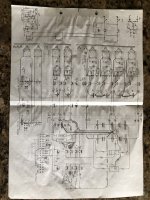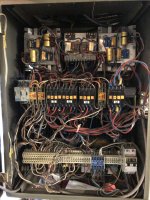😀 That could be me, but while it is true that I recently came into possession of ~70 2SK240Y from a fellow diyAudio member @bango which could be cannibalized to yield 140 K170Y, during the now 11 years that I have been looking for these JFETs I only ever managed to find 11 (!) J74Y, and even with the 140 K's I still cannot find matches for 2 of the J's. Moreover, the J's are spread all over the Y IDSS range in a way that I will be lucky if I can get one matched NNPP quad for a single stereo amplifier. 😛 So, no goldmine here, unfortunately...For JFETs, I was told that someone in Slovakia might have 100's of Y-grade.
That is too bad.
The Idss spread also applies to all grades, GR including.
To keep open loop gain always the same between examples, the only viable solution is the bypass current source as described in the article.
This has been successfully deployed in our two "Deluxe" prototypes.
That makes it possible to use GR grade without having to change any resistor values.
And to have reasonable yield for NNPP quads, one needs a minimum of 100 pcs each.
And expect 20% rejects, depending on matching tolerance.
Patrick
The Idss spread also applies to all grades, GR including.
To keep open loop gain always the same between examples, the only viable solution is the bypass current source as described in the article.
This has been successfully deployed in our two "Deluxe" prototypes.
That makes it possible to use GR grade without having to change any resistor values.
And to have reasonable yield for NNPP quads, one needs a minimum of 100 pcs each.
And expect 20% rejects, depending on matching tolerance.
Patrick
What are the part numbers of the SMD equivalents?So then how about 2SK246Y / 2SJ103Y ?
They are easier to get, especially the SMD equivalent.
They sound very differently if you trow them on the ceramic floor then if trow them on the wooden floor.How do the 2SK170 and 2SJ74 sound compared to, for example, the 2SK246 and 2SJ103?
I still haven't bothered to make a sonic comparison.
Hello Patrick,
Thank you for addressing the subject of "The Monster" on this forum given the difficulty it is these days to make this superb amplifier.
If I understand correctly regarding CCS, it is preferable to use a strong degenerate JFET in order to obtain better stability. So, wouldn't it make more sense to use BL-grade JFETs (2SJ103/2SK246 or SMD equivalent) rather than GR-grade (with Rs of higher value)?
Regards,
Didier
Thank you for addressing the subject of "The Monster" on this forum given the difficulty it is these days to make this superb amplifier.
If I understand correctly regarding CCS, it is preferable to use a strong degenerate JFET in order to obtain better stability. So, wouldn't it make more sense to use BL-grade JFETs (2SJ103/2SK246 or SMD equivalent) rather than GR-grade (with Rs of higher value)?
Regards,
Didier
A very good question.
The CCS only have 6.6V headroom.
Using 2SK208BL would eat too much into that.
But you can also consider using something like 2SK209BL, 2SK3557 or 2SK2394.
https://www.electronicdesign.com/te...w-voltage-n-jfets-under-consistent-conditions
https://audioxpress.com/article/mea...stent-conditions-an-update-using-modern-jfets
I chose 2SK208GR simply because I have them around, and their low Yfs makes trimming a bit easier.
Patrick
The CCS only have 6.6V headroom.
Using 2SK208BL would eat too much into that.
But you can also consider using something like 2SK209BL, 2SK3557 or 2SK2394.
https://www.electronicdesign.com/te...w-voltage-n-jfets-under-consistent-conditions
https://audioxpress.com/article/mea...stent-conditions-an-update-using-modern-jfets
I chose 2SK208GR simply because I have them around, and their low Yfs makes trimming a bit easier.
Patrick
Last edited:
I had a search around, but apparently no one has been using batteries directly for the Le Monstre.
At least they were not mentioning any details.
The problem of a large Lead Acid battery feeding into a large electrolytic capacitor is of course the inrush current.
How to control that, with the amp attached, and still maintain negligible resistance in between after the inrush, is not so obvious.
To me at least.
Patrick
.
At least they were not mentioning any details.
The problem of a large Lead Acid battery feeding into a large electrolytic capacitor is of course the inrush current.
How to control that, with the amp attached, and still maintain negligible resistance in between after the inrush, is not so obvious.
To me at least.
Patrick
.
Attachments
Maybe use an automotive starter relay?I worry about my switch and the caps, not the batteries.
Patrick
Probably larger than the rest of the unit but indestructible.
OK, I'll stop my funny suggestions now ... 😎
Jan
put the caps directly in // to the batteries and put the power on switch between the caps and the amp?
In the spirit of experimentation a friend once borrowed a stack of car batteries from his local garage to power his Aleph 5. It sounded flat and colourless compared to the mains for reasons that were never apparent or investigated!
For example, I used a small SE with only one battery, without any capacitors: The bass was deep black, funky and contoured, the colors consistently clear and rich, speed and clarity far above mains, but the treble was scratchy. But I quickly got used to it;-)
I would definitely try the Le Monstre only with batteries.
I would definitely try the Le Monstre only with batteries.
Aan Patric.So what was your solution ?
Patrick
FYI, & a little out of topic, I give you my minute schema ('83)
No chi-chi-ni-tra-la-la.
Attention, put the bat. (accu's) outside de building ... in open nature.
I hope that you find your correct PSU
Alles, Salukes.
Karel
Attachments
- Home
- Amplifiers
- Solid State
- Hiraga Le Monstre 2024

